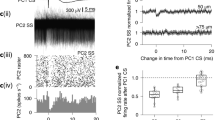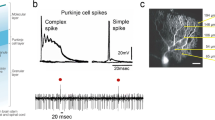Summary
Discharges of Purkinje cells (PCs) with simple (SS) and complex spikes (CS) in the c1zone of lobule Vc of the anterior lobe of the cerebellar cortex were analyzed in the decerebrate cat during a passive movement of the cat forepaw. The CS of the PC responded differentially and/or proportionally to the position of the extremity, amplitude of the movement, velocity and acceleration. Inphase and outphase responses of the climbing fiber (CF) system to sinusoidal movements could depend on the position of the extremity within the operational range. From these results we deduce that peripheral events can be signalled by the CF system. The possible function of the interaction between the two inputs at the PC level is discussed.
Similar content being viewed by others
References
Andersson G, Sjölund B (1978) The ventral spino-olivocerebellar system in the cat. IV. Spinal transmission after administration of clonidine and L-DOPA. Exp Brain Res 33: 227–240
Bauswein E, Kolb F P, Rubia F J (1978) Responses of cerebellar units in the awake Rhesus monkey during active and passive movements. Pflüg Arch [Suppl] 373: R 73
Ebbeson S O E (1968) A connection between the dorsal column nuclei and the dorsal accessory olive. Brain Res 8: 393–397
Eccles J C, Sabah N H, Schmidt R F, Táboříková H (1972a) Cutaneous mechanoreceptors influencing impulse discharges in cerebellar cortex. I. In mossy fibers. Exp Brain Res 15: 245–260
Eccles J C, Sabah N H, Schmidt R F, Táboříková H (1972b) Cutaneous mechanoreceptors influencing impulse discharges in cerebellar cortex. II. In Purkinje cells by mossy fiber input. Exp Brain Res 15: 261–277
Eccles J C, Sabah N H, Schmidt R F, Táboříková H (1972c) Cutaneous mechanoreceptors influencing impulse discharges in cerebellar cortex. III. In Purkinje cells by climbing fiber input. Exp Brain Res 15: 484–497
Eccles J C, Sabah N H, Schmidt R F, Táboříková H (1972d) Integration by Purkinje cells of mossy and climbing fiber from cutaneous mechanoreceptors. Exp Brain Res 15: 498–520
Holst E von, Mittelstaedt H (1950) Das Reafferenzprinzip. Naturwissenschaften 37: 464–476
Ishikawa K, Kawaguchi S, Rowe M J (1972a) Actions of afferent impulses from muscle receptors on cerebellar Purkinje cells. I. Responses to muscle vibration. Exp Brain Res 15: 177–193
Ishikawa K, Kawaguchi S, Rowe, M J (1972b) Actions of afferent impulses from muscle receptors on cerebellar Purkinje cells. II. Responses to muscle contraction: Effects mediated via the climbing fiber pathway. Exp Brain Res 16: 104–114
Kolb F P, Rubia F J (1976) Responses of cerebellar single units to changes in the parameter of a passive movement in the decerebrate cat. Pflüg Arch [Suppl] 365: R 41
Larson B, Miller S, Oscarsson O (1969a) Termination and functional organisation of the dorsolateral spino-olivocerebellar path. J Physiol (Lond) 203: 611–640
Larson B, Miller S, Oscarsson O (1969b) A spinocerebellar climbing fibre path activated by the flexor reflex afferents from all four limbs. J Physiol (Lond) 203: 641–649
Leicht R, Rowe M J, Schmidt R F (1973) Cutaneous convergence on to the climbing fibre input to cerebellar Purkinje cells. J Physiol (Lond) 228: 601–618
Maekawa K, Simpson J I (1972) Climbing fiber activation of Purkinje cells in the flocculus by impulses transferred through the visual pathway. Brain Res 39: 245–251
Oscarsson O (1967) Functional significance of information channels from spinal cord to the cerebellum. In: Neurophysiological basis of normal and abnormal motor activities. 3rd symposium of the Parkinson's desease information and research center. Yahr, M D, Purpura D P (eds) Hewlett NY: Raven Press pp 93–117
Oscarsson O (1968) Termination and functional organisation of the ventral spino-olivocerebellar path. J Physiol (Lond) 196: 453–478
Oscarsson, O (1969) Termination and functional organisation of the dorsal spino-olivocerebellar path. J Physiol (Lond) 200: 129–149
Rubia F J, Kolb F P (1977) Information transmission to the cerebellum of a passive movement in the decerebrate cat. In: Proceedings of the International Union of Physiological Sciences, Abstr No 1911
Rubia F J, Kolb F P (1978) Responses of cerebellar units to a passive movement in the decerebrate cat. Exp. Brain Res 31: 387–401
Rushmer D S, Roberts W J Augter G K (1976) Climbing fiber responses of cerebellar Purkinje cells to passive movements of the cat forepaw. Brain Res 106: 1–20
Sedgwick E M, Williams T D (1966) Afferent connexions to single units in the inferior olive of the cat. Nature 212: 1370–1371
Sedgwick E M, Williams T D (1967) Responses of single units in the inferior olive to stimulation of the limb nerves, peripheral skin receptors, cerebellum, caudate nucleus and motor cortex. J Physiol (Lond) 189: 261–280
Simpson J I, Alley E (1974) Visual climbing fiber input to rabbit vestibulo-cerebellum: A source of direction-specific information. Brain Res 82: 302–308
Sjölund B (1978) The ventral spino-olivocerebellar system in the cat. V. Supraspinal control of spinal transmission. Exp Brain Res 33: 509–522
Thach W T (1967) Somatosensory receptive fields of single units in cat cerebellar cortex. J Neurophysiol 30: 675–696
Thach W T (1968) Discharge of Purkinje and cerebellar nuclear neurons during rapidly alternating arm movements in the monkey. J Neurophysiol 31: 785–797
Thach W T (1970) Discharge of cerebellar neurons related to two maintained positions and two prompt movements. II. Purkinje cell output and input. J Neurophysiol 33: 537–547
Uddenberg N (1968a) Differential localisation in dorsal funiculus of fibres originating from different receptors Exp Brain Res 4: 367–376
Uddenberg N (1968b) Functional organisation of long, second-order afferents in the dorsal funiculus. Exp Brain Res 4: 377–382
Voogd J (1969) The importance of fiber connections in the comparative anatomy of the mammalian cerebellum. In: Neurobiology of cerebellar evolution and development, Llinás R (ed) Chicago, American Medical Association, pp 493–514
Author information
Authors and Affiliations
Additional information
Preliminary results were reported at the 47th meeting of the Deutsche Physiologische Gesellschaft in Regensburg (Kolb and Rubia, 1976) and at the XXVIIth International Congress of Physiological Sciences in Paris (Rubia and Kolb, 1977)
Rights and permissions
About this article
Cite this article
Kolb, F.P., Rubia, F.J. Information about peripheral events conveyed to the cerebellum via the climbing fiber system in the decerebrate cat. Exp Brain Res 38, 363–373 (1980). https://doi.org/10.1007/BF00237516
Accepted:
Issue Date:
DOI: https://doi.org/10.1007/BF00237516




